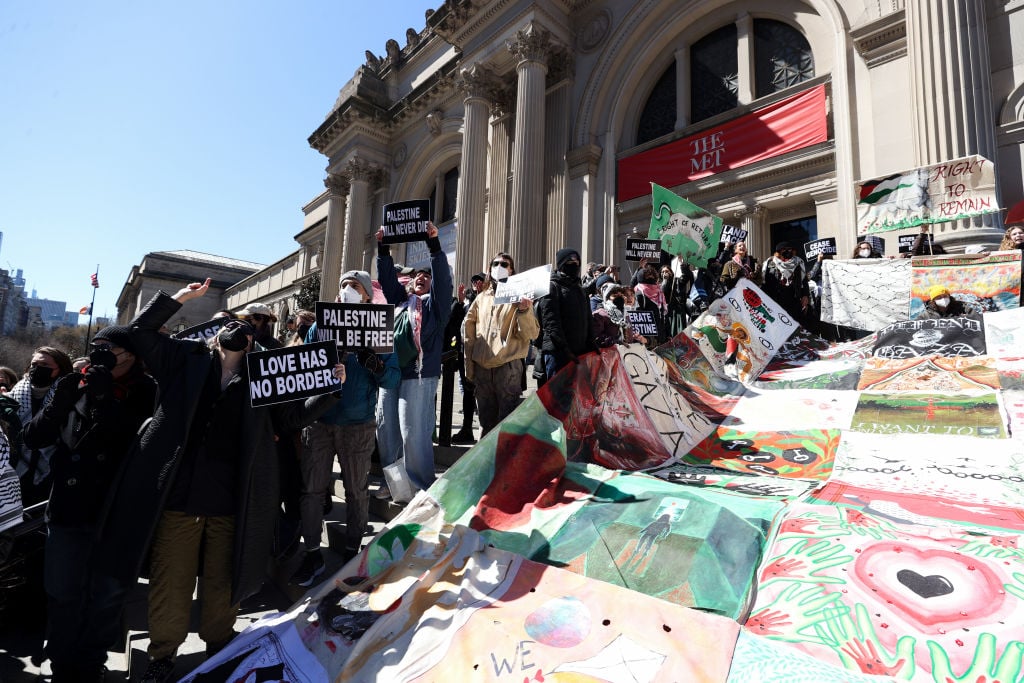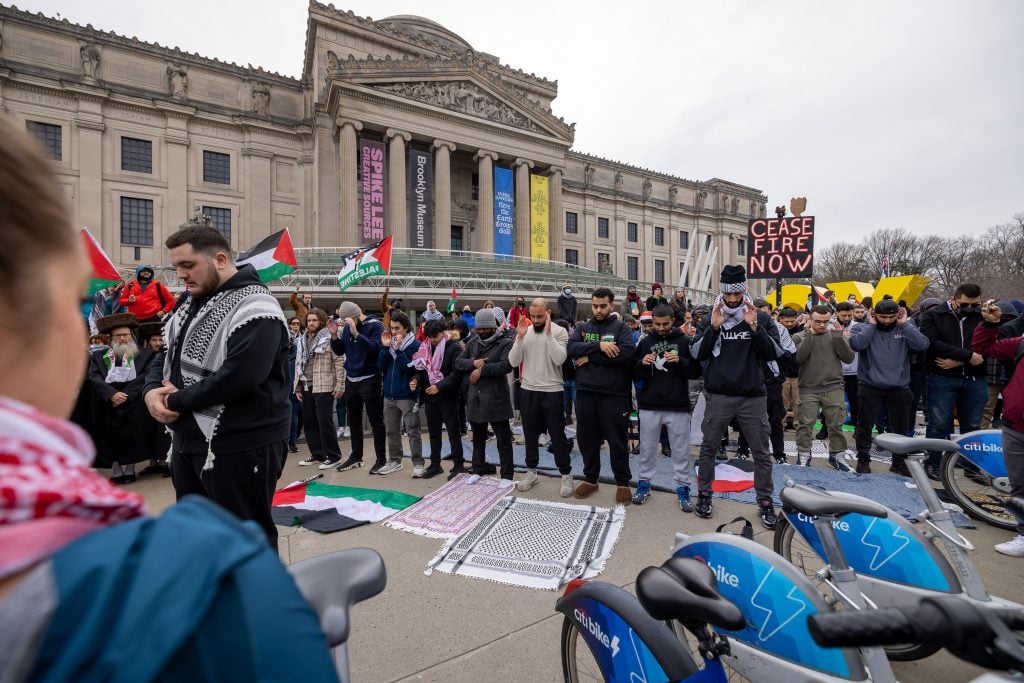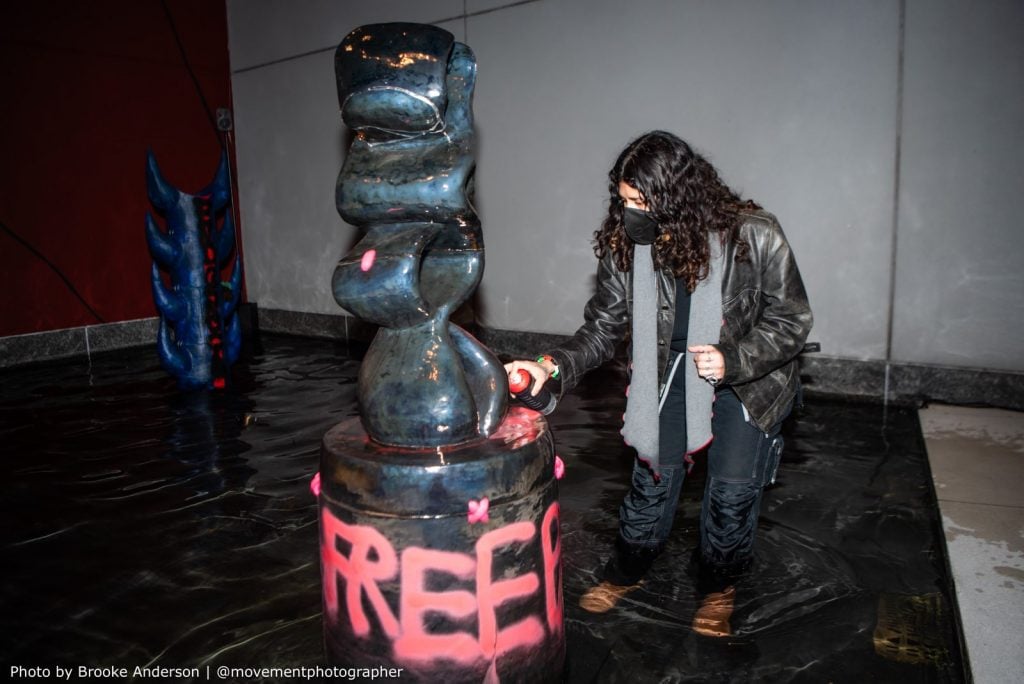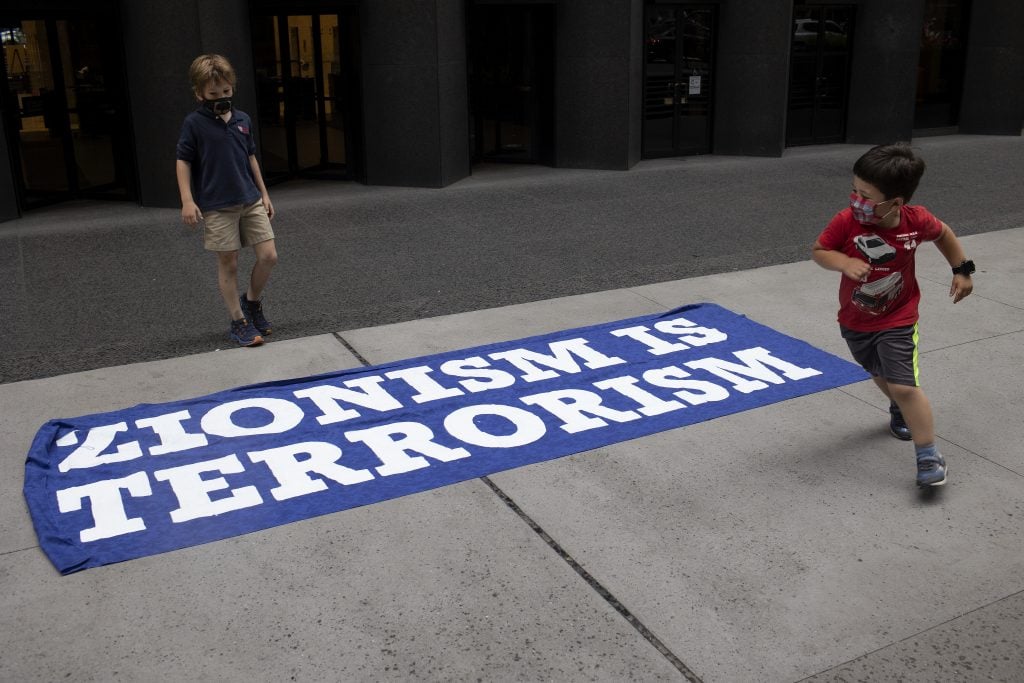
Museums are struggling with how to adequately respond to public protests and staff demands calling for support of Palestine, among them the Metropolitan Museum, and Museum of Modern Art (MoMA), and the Brooklyn Museum in New York, as well as the Yerba Buena Center for the Arts (YBCA) in San Francisco. As Israel’s war in Gaza continues, and protests calling for a ceasefire proliferate at cultural institutions, few institutions have taken measurable steps to address or even acknowledge the demands made on them.
Earlier this month, staff at the Met delivered an open letter to director and chief executive Max Hollein, asking for the institution to publish a statement calling for an end to the bombing of Gaza and take steps to better attribute and showcase its collection of Palestinian artworks.
The museum, like others, has also been the site of repeated protests. On Sunday, March 24, around 350 activists gathered on the steps of the Met to unroll a vast 30- by 50-foot quilt declaring support for Palestine while calling for a ceasefire. Others distributed flyers detailing the museum’s alleged ties with Zionists. The protesters demanded that the museum cut ties with board members who have a vested interested in certain companies, such as defense contractor RTX (formerly Raytheon), which sells weapons to Israel.

Hundreds of pro-Palestinian supporters, holding banners and flags, gather on the steps of the Metropolitan Museum to hold a pro-Palestinian demonstration in New York City, New York, United States on March 24, 2024. Photo: Lokman Vural Elibol/Anadolu via Getty Images.
The Met declined to comment on the protest. Meanwhile, staffers said that while Hollein provided an initial response to their open letter, he has “not made any firm commitments,” according to a Hyperallergic report.
Profound silence
Staff at MoMA say they have yet to receive any response to their open letter, published in February.
“Museum leadership has completely ignored the open letter, though there were a handful of seemingly unproductive conversations between individual employees and supervisors in the days following the letter’s release,” a MoMA employee who signed the letter said in an email. “This willful disregard underlines the institution’s ‘profound silence’ as mentioned in the letter and its continued disregard for the crisis in Gaza itself.”
As part of their demands, MoMA staffers have called for the museum’s leadership to commit to either the Palestinian Campaign for the Academic and Cultural Boycott of Israel (PACBI) in its entirety or conduct a thorough and transparent review of PACBI to develop its own set of guiding principles—a call that has been echoed in most of the museum staff open letters issued recently.
The Brooklyn Museum was one of the first institutions to face an open letter from its staff in November, just weeks after the war in Gaza broke out. While the institution has not responded publicly, a spokesperson noted that in an email that discussions have been happening internally over the last several months.
“Since some members of our staff wrote a letter in November asking for the Museum to speak up, board and staff have been coming together in essential conversation to discuss the role of museums in the face of such a tragic, volatile, and divisive situation,” the Brooklyn Museum representative said.

Pro-Palestine demonstrators pray during a rally in front of the Brooklyn Museum of Art calling for a ceasefire. The Ministry of Health in Gaza has said that the death toll has surpassed 30,000 people, around two-thirds of them women and children, since the Israeli-Hamas conflict started on October 7, 2023. Photo: by Michael Nigro/Pacific Press/LightRocket via Getty Images.
The museum did not reveal details around the conversations and did not answer questions specific to how it was promoting the work of Palestinian artists or otherwise navigating the tensions around political divisions. “We remain committed to fostering an environment where diverse perspectives are valued and received with respect, grace, and sensitivity,” the spokesperson said.
Reactive responses
Responding reactively to political actions ultimately undermined the YBCA, however. The arts center is much smaller and more regionally focused than international institutions like the Met or MoMA, which in some ways allows it to be nimbler in response to the demands placed on it by its staff and wider community. Nevertheless, earlier this month, Sara Fenske Bahat, the interim CEO of the YBCA, resigned amid intense pushback over the institution’s response to a recent pro-Palestine protest that took place at the institution.
Her resignation immediately followed a call for a special hearing to look into the publicly funded arts center issued by the San Francisco County Supervisor Hillary Ronen. Fenske Bahat, who is Jewish, said the “vitriolic and antisemitic backlash” directed at her personally in the wake of the protest made serving in her role “intolerable,” according to a statement she issued to the San Francisco Chronicle. “I no longer feel safe in our own space, including due to the actions of some of our own employees,” she added.
Dissension among staff and the wider public began when eight artists with the Bay Area Artists Against Genocide collective altered their works in an exhibition titled “Bay Area Now 9” as part of a protest against the war in Gaza on February 15. After the incident, the museum closed to the public for several weeks and issued controversial statements calling the action “disruptive.” The center’s leadership endured widespread criticism; critics claimed the closure and statements amounted to censorship and called for a boycott of the center.
On February 27, a group of YBCA staff published an open letter in support of the artists, which has since been signed by over 800 people, including high-profile figures like artist and activist Emory Douglas, a major figure in the Blank Panther Party, and San Francisco Poet Laureate Tongo Eisen-Martin.
“This culture of top-down decision making has continued to exploit the labor, expertise, and care of current staff, many of whom are artists and culture workers themselves, and who belong to the very communities that YBCA is designed to serve,” the letter said.
The staffers demanded that the YBCA call for a permanent and unconditional ceasefire and a public commitment to PACBI, as well as issue an apology to the Bay Area Now 9 artists and reopen the exhibition.
“Closing the museum down for an entire month after our protest, that is censorship,” said Paz G, one of the Bay Area artists who altered their own sculptures in the show by spray painting the phrase “Viva Palestina—Free Palestine” on it as part of the February 15 protest. They added that the decision to close affected public programming, forcing the cancellation of a dance festival that was scheduled for the following weekend. And it meant much of YBCA’s staff did not work and therefore did not get paid.
The exhibition has now reopened, though with new signage to “provide context regarding the alterations made by the artists,” the museum said in a statement on March 14. “The opinions expressed by each artist are their own and are not those of YBCA.”

Paz G is pictured altering one of their works during an action held in support of Palestine at the Yerba Buena Center for the Arts. Photo: Brooke Anderson.
Ideological impasse
“What we are seeing right now is a lot of these institutions just failing to honor the artists that they show,” said Paz G, noting that institutions that want to show work by “liberation-focused and revolution-oriented” artists must be ready to stand with them.
The artist claimed that institutions are “having a hard time with Zionist funders” that allegedly dictate in their contracts that organizations accepting their money cannot speak against the state of Israel. However, Paz G admitted their contract with YBCA had no such stipulations, though it does say the board of directors can remove their work at any point.
“We have struggled with how to best respond, while balancing these important considerations against our responsibilities to the organization and to all of our community members. After unsuccessful attempts to engage with the artists, we were faced with little choice but to temporarily close the BAN9 exhibition,” the YBCA said in a statement.
Frequently in open letters, such as one sent to MoMA in New York in February, signatories have asked for the institutions to draft statements supportive of Palestinians in Gaza, which largely go unaddressed. MoMA has received more than one of these letters over the years and has yet to offer any statement. In 2021, nearly 300 people signed a protest letter against the museum’s board accusing members Ron Lauder, Leon Black, Steven Tananbaum, and others of “supporting apartheid rule” and “artwashing” the “occupation of Palestine” because of their ties to Israel. A subsequent rally outside the museum organized by Strike MoMA drew several hundred pro-Palestinian protesters. The museum did not respond to the letter or action; Black, Lauder, and Tananbaum are still listed as members of the board.
In its recent statements, YBCA seems to be the only museum that has even directly acknowledged this request as of late. It said it had refrained from penning such support to allow its stakeholders and members of the community the ability to hold their own viewpoints on the divisive war.
As for the Met, when asked whether it intended to release any statements regarding Gaza or its funders who have ties to Israel, the museum redirected the question and highlighted its recent efforts to showcase work by Arab and Palestinian artists—a direct response to one of the demands made by staffers in their open letter.

Palestinian activists held a rally outside of the Museum of Modern Art to protest what they claim to be board members funding of the Israeli occupation of Palestine, June 11, 2021, in midtown Manhattan, New York City. Photo: Andrew Lichtenstein/Corbis via Getty Images.
The museum spokesperson said it “is committed to reflecting a wide array of experiences and views” throughout its collection, exhibitions, and programs, and “strives to be a source of solace, protection, and community for both our staff and our diverse audiences.”
Among its efforts to highlight Palestinian artists, the museum’s Islamic Art department and Ratti Textile Center is currently partnering on research into Palestinian dresses in the collection, which will be presented in articles published in the coming weeks on the museum’s website. And, the museum is currently completing the renovation of the galleries for Ancient Near Eastern and Cypriot art, opening in 2026.
Long-term change
While consistently mounting pressure on art institutions to take a stand against the war in Gaza may be yielding isolated concessions like exhibition recontextualization, it is not enough to foster long-term change, according to many.
Courtney Desiree Morris, an artist who participated in the YBCA protest, said that the museum’s contextualizing placards in the recently reopened Bay Area Now 9 show are “disingenuous.” She said there are three signs, including one that provides a general statement that the works were altered and have not been further changed, and another offering a content warning that the works now contain messages about the “Israel-Hamas war,” a description she contested.
“It is not a war between Israel and Hamas. It is a genocide being carried out in the name of safety and insecurity,” Morris said. She added that it was “astonishing” that the museum “felt the need” to put up the content warning signs and somehow distance themselves or disavow the works of artist “as if the work is now somehow incendiary or dangerous or inflammatory.”
“We’re asking for long term representation and long-term divestment from working with these organizations and collectors, specific people who are war profiteers who do benefit or contribute to the state of Israel and contribute to genocide,” Paz G said. To that end, a statement or an exhibition reshuffle from a museum “can only go so far.”
Morris said that artists and museums workers are “definitely paying attention to each other” and “getting a sense of what might work in applying pressure to institutions” but not orchestrated at a level larger than that.
She challenged any characterization that protest groups across institutions are in cahoots. “There’s no ‘Artists for Palestine’ headquarters. We’re not there yet,” she said. “We’re operating on somewhat of an ad hoc basis. Yes, we have learned from the intervention of artists in other places—but, for example, we had no idea an intervention at the Brooklyn Museum [in February] was happening at the same time as ours.”
Still, Morris urged other artists and employees at other institutions to speak up about the war, specifically encouraging museums to support the Boycott, Divest, and Sanctions movement. Artists and culture workers have a responsibility to speak up “in whatever ways they can” at other institutions, she said.
Follow Artnet News on Facebook:
Want to stay ahead of the art world? Subscribe to our newsletter to get the breaking news, eye-opening interviews, and incisive critical takes that drive the conversation forward.
